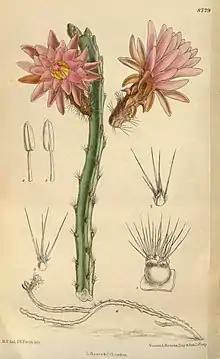Weberocereus tunilla
Weberocereus tunilla is an epiphytic cactus native to Costa Rica, Nicaragua and Panama. It is the type species of Weberocereus. Its flower emits an unpleasant musky smell after opening and is pollinated by bats. The flowers are an example of flagelliflory.[2]
| Weberocereus tunilla | |
|---|---|
 | |
| Scientific classification | |
| Kingdom: | Plantae |
| Clade: | Tracheophytes |
| Clade: | Angiosperms |
| Clade: | Eudicots |
| Order: | Caryophyllales |
| Family: | Cactaceae |
| Subfamily: | Cactoideae |
| Genus: | Weberocereus |
| Species: | W. tunilla |
| Binomial name | |
| Weberocereus tunilla | |
| Subspecies | |
| |
| Synonyms[1] | |
| |
Subspecies
- Weberocereus tunilla subsp. biolleyi, syns. Weberocereus biolleyi, Weberocereus panamensis – Costa Rica, Nicaragua, Panama. Stems nearly cylindrical, 4–6 mm thick. Flowers 5–6 cm long, pinkish
References
- "Weberocereus tunilla (F.A.C.Weber) Britton & Rose". Plants of the World Online. Kew Science. Retrieved 2021-12-04.
- Tschapka, M.; Helversen, O. von; Barthlott, W. (1999). "Bat pollination of Weberocereus tunilla, an epiphytic rain forest cactus with functional flagelliflory". Plant Biology. 1 (5): 554–559. doi:10.1111/j.1438-8677.1999.tb00783.x. ISSN 1438-8677.
This article is issued from Wikipedia. The text is licensed under Creative Commons - Attribution - Sharealike. Additional terms may apply for the media files.